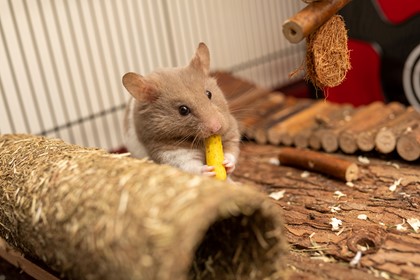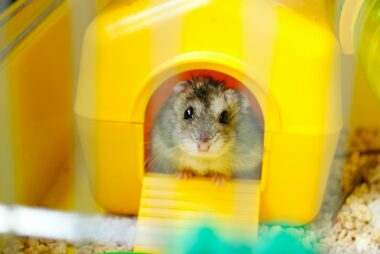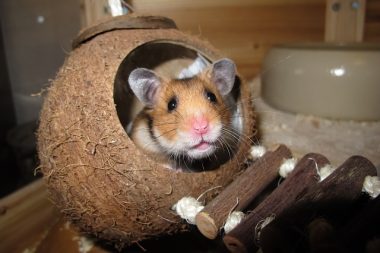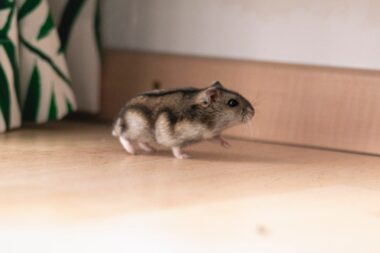
Bringing home a pet can be one of the most exciting adventures. Hamsters are among some of the most popular pets chosen by both kids and adults. It makes a lovely choice for people living in a cramped apartment space. With proper care and maintenance, hamsters can easily live for 2 to 3 years. They are cute, active, and so full of life. So, if you learn how to take care of a hamster, you are left with a furry companion who can cheer you up even on the gloomiest day.
Hamsters are nocturnal, and so you might not find them to be too active or eager to play during the day time. You can choose dwarf hamsters if you are looking for a more social pet. It tends to be active during the dawn and dusk as well. Wild hamsters are not great choices for pets as they tend to hibernate for a long duration.
Hamster cage tips
The first step in learning how to take care of a hamster is to learn about the essential tips to pick the right hamster cage. Those fancy hamster cages, the teeny ones you find in many pet stores with the mazes and wheels, might not be the best your hamster can get. Your hamster would definitely need these toys and activity areas, but they should be positioned safely in a roomy cage. A good cage lets the hamster feel safe and provides ample space for your pet to play. Both these factors are essential for the healthy growth and development of your hamster.
· The cage for a single hamster should be at least of 450sq.inch of floor space. The height of the cage depends primarily on the wheel and other toys you choose.
· Wire mesh cages are some of the most popular choices for hamsters. But you should be careful about the grid size or the gap between the bars. Baby hamsters, as well as dwarf hamsters, can easily escape through small gaps. Sometimes they get stuck and it gets painful to ease them out of the gap.
· The floor of the cage should, however, be a flat surface and not wired. This is to mainly ensure that your hamster’s feet do not get caught in the mesh.
· There are commercial hamster cages built for easy maintenance. If you cannot spend a huge sum on a hamster cage there are many ways to build one yourself. This also lets you add to the cage’s aesthetics and create a personalized setup for your pet.
· Whether it is a store-bought cage or DIY version, focus on the ventilation. As these are nocturnal animals, lighting can easily be adjusted. But ventilation is one thing you cannot compromise on. If you choose glass tanks as hamster cages temporarily, ensure that the top portion is not sealed. Use a wired top until you can move your hamster to a wired cage with solid tray bottom.
Bedding and cleaning
The bedding you choose for the hamster cage determines how easy it is to maintain the cleanliness of the cage. It also influences the comfort of the cage for your pet. Absorbent beddings of different kinds are available. Aim for bedding of height 2-6 inches. This will absorb urine and odor and provide the pet space to burrow. Avoid shavings of softwood that can lead to respiratory troubles in hamsters. Cotton, on the other hand, might lead to the pet getting tangled in the bedding. Aspen bedding would be an efficient choice for hamster cages.
Spot cleaning the hamster cage frequently will help in prolonging the duration between deep cleaning. It would also help in maintaining the cage hygiene. Food bowls, as well as water bottles, should be emptied out and cleaned daily. Most aspen beddings with good absorbing power should be replaced once a week. This is applicable for cages with a single hamster in the habitat. If there are two hamsters, you might have to clean more frequently. When you clean the cage remember to clean the toys, tunnels, and wheels as well. There tend to be food scraps in odd corners in the cage. Washing the cage thoroughly and deep cleaning the habitat periodically would be essential. Make sure that you create a safe temporary play area for your pet when you clean the habitat and get it ready.
Hamster feeding tips

The next important thing about knowing how to take care of a hamster would be to know what to feed and what not to feed your hamster. Food and water should be available for your hamster at all times. They tend to have erratic feeding patterns and seldom get thirsty. There are spill-free hamster feeding bottles available. You can easily hang these inside the hamster cage. For food, avoid plastic and choose a sturdy metal bowl or even an earthenware bowl that doesn’t easily topple.
Pick quality pellet foods for your hamsters. They tend to be picky eaters. So, even if it is a small quantity that your pet eats it should get the right dose of daily nutrients. To make sure that your pet is well-fed, you can place a few pellets here and there in the cage. Place a few inside the tunnels or even in the hamster wheel. It is alright to offer carrots, apples, kale, celery, and other hamster-safe vegetables as treats. Most other human foods are harmful to hamsters. Be particularly wary of sugary treats and food items. If you do not know what vegetables are safe, you can also stick with commercial hamster treats made of natural ingredients.
Few hamster care tips for nurturing a new hamster
Paying attention to taking care of a hamster during the first few days will make it easier for the pet to get adjusted to its new home.
· Partially covering the cage would work for the first few days. While still giving it enough light and ventilation, this will give it some privacy. It will also shield the pet from too many distractions stressing it out.
· Do not try to pet or pick your hamster right when you bring it home. When you choose a pet, you should look for one that is not too shy or timid. It should be happy enough to come and sniff your hand. But once you bring it home, avoid forcibly comforting it or picking it. Let it get used to you as you replace its food and water. It is all about earning its trust first and then picking it up.
· Try and talk to your hamster in a gentle tone. It should get used to your smell and voice. When your hamster starts trusting you, gently take your hand close to the pet. Allow it to come to you when it feels comfortable.
Mistakes to avoid when you bring home a pet hamster
· Do not place the hamster cage in a noisy area in your house. Close to a window overlooking a noisy street, for example, would be a bad spot for the hamster. A spot near heavy machinery or even your washing machine or dryer might be bad for your pet. These situations can stress out the pet and make it difficult for the hamster to trust and socialize with the humans in the house.
· Avoid placing the hamster cage in a sunny spot. Do not place it directly below a skylight or too close to a large window that receives ample sunlight throughout the day.
· Do not let small children handle hamsters. When they are not held gently, they tend to get nervous. Nervousness might make them nippy. Another problem is that they are gentle creatures. They can easily be injured when dropped accidentally. Be very gentle when you pick the hamster and place it back.
· Don’t let your hamster near other pets like dogs and cats. You might have the most obedient, well-trained dog but still, this would be a bad idea.
· Placing more than one hamster in a cage can be a bad idea unless you know about the breed. Some breeds like the Syrian hamsters love to be housed alone. Male and female hamsters breed quickly and have a huge litter. So, it is better to separate hamsters in different cages.
· Housing a hamster and guinea pig in the same cage is another mistake some pet owners do. This would also be bad for both your pets.
· Do not choose tiny hamster wheels for your pet. Larger wheels where the pet doesn’t have it flex its spine would be healthy choices for long-term use.
If you thought smaller pets require very little care, think again! Do not venture into raising a hamster without knowing every little detail about how to take care of a hamster. One careless mistake can drastically affect the growth and development of your pet. If you have made up your mind to bring a pet hamster home, make sure that you are ready to spare a little space, enough time, lots of patience, and oodles of love.








